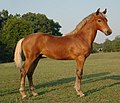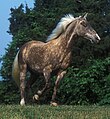Wind colors
The term wind color gene is a colloquial term that is used in the German language for the genetics “silver”, which influences the horse 's coat color in domestic horses . The official genetic name "Silver" was chosen based on the English term Silver Dapple, which is the name for the coat color produced by the gene. The term “silver” is also used again for the term silver locus . The term "Windfarben" is a German translation of the Icelandic term "Vindótt" which describes the same coat color. Since there is no German term for this coat color, one falls back either on the English term "Silver Dapple" or the translation "Windfarben".
genetics
The domestic horse's silver gene is a mutation of a gene location that corresponds to the silver locus PMEL17. The responsible gene is represented with a Z Research on the genetic identification of Silver was published in 2006.
The mutation is inherited as an autosomal dominant trait. Silver only influences horses whose basic color is genetically black or brown, and leads to a lightening of their coat. Silver is therefore counted among the lightening color genes. Silver can lighten the black mane of browns to white and the black fur of black horses to chocolate brown with light long hair. Silver has no effect on pheomelanin , so horses that are genetically foxes (red) will not show any color changes or lightening in the coat. Foxes can pass the color on to their offspring if they are carriers of the silver gene.
Horses that are homozygous for silver are often lighter in color than horses that are only heterozygous for silver.
Silver interacts with other color genes. It describes interactions with the genetics of the mold and the cream gene.
The gene occurs quite often in the Icelandic horse , the American miniature horse , the Comtois or the Rocky Mountain Horse . It is less common in other breeds.
Appearance
There is no uniform appearance of silver, as the phenotype depends on which basic color and which modifying color genes come together in a horse. A Silver Bay looks different from a Silver Black or a Silver Cream. You can roughly say foals with the wind color gene are quite light and have lightened to gray long hair (mane and tail). You have strikingly white eyelashes. The hooves of young animals are streaked in black and white until about the end of their first year of life, then they become darker and lose the streaks.
The white eyelashes typical of the gene in a Rocky Mountain foal
A fox -colored Morgan with a silver-dapple gene: no influence of the gene can be seen.
Versions of Silver
Rappwindfarben or Silver Dapple Black
Rappwind-colored horses or English Silver Dapple are black horses that are lightened by the wind-colored gene. They can have a dark body color with a silver mane and tail, others are evenly chocolate brown, sometimes with a significantly lighter mane, but sometimes not. Many horses with silver dapple actually have dapple fur, but this characteristic does not have to be present. Sometimes it only occurs when the coat changes and is not visible all year round.
Brown wind colors / Silver Dapple Bay
Brown wind-colored horses or English Silver Dapple Bay are browns that are lightened by the wind color gene. Browns with silver dapple can also have light long hair. Their legs are lightened, the rest of the body remains unchanged because it (unless it is a black and brown) has no black fur.
Morgan with Silver dapple.
Other color options
Since the wind color gene only brightens eumelanin but not pheomelanin, all colors derived from foxes cannot be lightened by this gene. Fuchsschecken, Palominos, Rotschimmel (regardless of whether they are real gray or spike-haired horses) and foxes remain unchanged if they carry the gene.
All colors that are derived from browns or blacks can be influenced. Dun, bustard, black pinto or brown with spotted and mold, as long as they are not yet completely white, can also be brightened up with Silver dapple.
Silver Dun
Combination of silver and fallow
Silver Cream
Combination of silver and cream genes
Possible confusion
Most often horses of the color silver or wind colors are confused with foxes. In a misleading way, some of them were even registered as foxes by the breeding associations. Foxes can show lightened long hair by "flaxing" (mane and tail). The colors may be similar for the inexperienced observer, but actually not identical. Even if foxes or palominos are darkened by Sooty, they have been mistaken for wind-colored horses due to the gray parts in the fur that occur with this coloration. Another possibility of confusion exists with the coat color Mushroom , which was proven in the original Shetland pony. Mushroom comes so close to the color of silver that dark versions of the color can sometimes not be distinguished from silver in purely visual terms. However, the difference can be proven genetically.
- Darker palominos can look the same or very similar to brown ones with wind colors
- Sometimes light foxes can hardly be distinguished from horses that are brown and windy
Haflinger light fox, i.e. a fox with the Flaxen gene
The color of the Black Forest cold blood can also be traced back to flaxes. Here a dark chestnut with flaxes
- Wind-colored ones have also been mistaken for white apples . The gray horse has a mixture of black and white hair in the gray areas of the fur.
- Foxes can be reminiscent of a horse the color of a windpill, but they usually appear less gray.
health
Rocky Mountain Horses often have eye malformations and these were thought to be related to the wind color gene. In the meantime, it has been proven in crossing tests that there is a connection. Another study found that the gene responsible for the eye damage must be exactly in the area in which the wind color gene is located and only the mutations responsible for the wind color were found there. In addition, it was found that horses homozygous for the wind color gene can have severe eye damage, while heterozygous horses only have minor malformations that are not recognizable to the layman and have no significant influence on the horses' eyesight.
Races
The following breeds are known to have the wind color gene: Icelandic horse , Shetland pony , Comtois , American Miniature Horse , Rocky Mountain Horse , Ardennes , Quarter Horse , Morgan (horse) , Swedish Warmblood , Welsh A , Irish Tinker etc.
Although the breed is Black Forest Cold blood consists almost exclusively of foxes and has been confirmed by genetic tests, it was shown in a study that a very small percentage (0.8%) of the wind color gene can also be found in them. As described above, this has no effect on the fox color. It is very likely that it was introduced into the breed several generations ago through the crossing of Ardennes, which was permitted at the time.
See also
Web links
swell
- Emma Brunberg, Leif Andersson, Gus Cothran, Kaj Sandberg, Sofia Mikko, Gabriella Lindgren: A missense mutation in PMEL17 is associated with the Silver coat color in the horse. In: BMC Genet. 7, 2006, p. 46. PMID 17029645 doi: 10.1186 / 1471-2156-7-46
- Emma Brunberg: Mapping of the silver coat color locus in the horse. Institutions for husdjursgenetik Sveriges Landbruksuniversitet, Uppsala, Sweden 2006.
- M. Reissmann, J. Bierwolf, GA Brockmann: Two SNPs in the SILV gene are associated with silver coat color in ponies. In: Anim Genet. 38 (1), 2007 Feb, pp. 1-6. PMID 17257181
- BH Grahn, C. Pinard, S. Archer, R. Bellone, G. Forsyth, LS Sandmeyer: Congenital ocular anomalies in purebred and crossbred Rocky and Kentucky Mountain horses in Canada. In: Can Vet J. 49 (7), 2008 Jul, pp. 675-681. PMID 18827844
- LS Andersson, R. Juras, DT Ramsey, J. Eason-Butler, S. Ewart, G. Cothran, G. Lindgren: Equine Multiple Congenital Ocular Anomalies maps to a 4.9 megabase interval on horse chromosome 6. In: BMC Genet. 9 (1), 2008 Dec 19, p. 88. PMID 19099555
- S. Mömke, R. Schrimpf, C. Dierks, O. Distl: Incidence of Mutation for Silver Coat Color in Black Forest Horses. In: IJAS. 3 (4), 2013, pp. 859-861.















